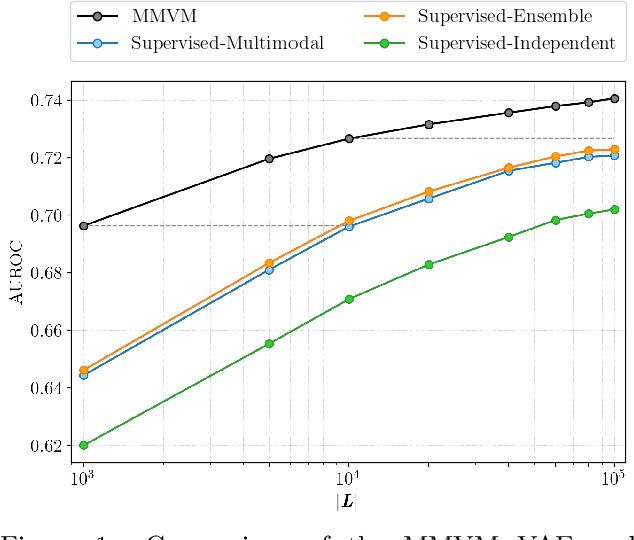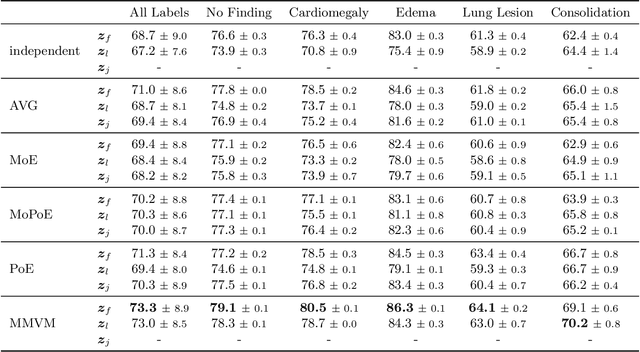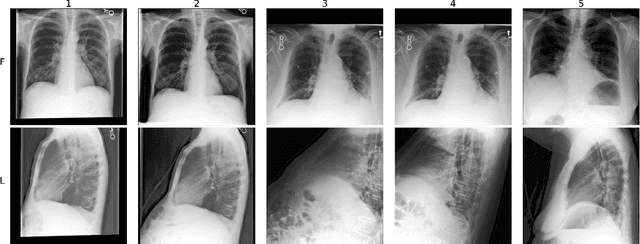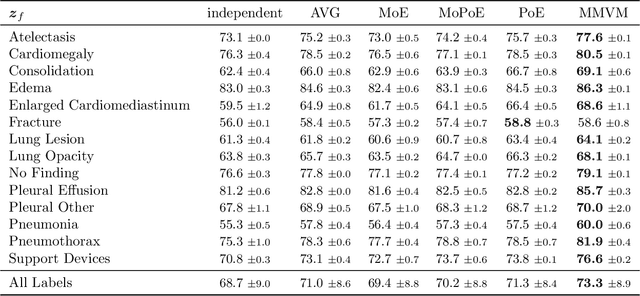Norbert Fortin
Weakly-Supervised Multimodal Learning on MIMIC-CXR
Nov 15, 2024



Abstract:Multimodal data integration and label scarcity pose significant challenges for machine learning in medical settings. To address these issues, we conduct an in-depth evaluation of the newly proposed Multimodal Variational Mixture-of-Experts (MMVM) VAE on the challenging MIMIC-CXR dataset. Our analysis demonstrates that the MMVM VAE consistently outperforms other multimodal VAEs and fully supervised approaches, highlighting its strong potential for real-world medical applications.
Optimal Transport for Latent Integration with An Application to Heterogeneous Neuronal Activity Data
Jun 27, 2024



Abstract:Detecting dynamic patterns of task-specific responses shared across heterogeneous datasets is an essential and challenging problem in many scientific applications in medical science and neuroscience. In our motivating example of rodent electrophysiological data, identifying the dynamical patterns in neuronal activity associated with ongoing cognitive demands and behavior is key to uncovering the neural mechanisms of memory. One of the greatest challenges in investigating a cross-subject biological process is that the systematic heterogeneity across individuals could significantly undermine the power of existing machine learning methods to identify the underlying biological dynamics. In addition, many technically challenging neurobiological experiments are conducted on only a handful of subjects where rich longitudinal data are available for each subject. The low sample sizes of such experiments could further reduce the power to detect common dynamic patterns among subjects. In this paper, we propose a novel heterogeneous data integration framework based on optimal transport to extract shared patterns in complex biological processes. The key advantages of the proposed method are that it can increase discriminating power in identifying common patterns by reducing heterogeneity unrelated to the signal by aligning the extracted latent spatiotemporal information across subjects. Our approach is effective even with a small number of subjects, and does not require auxiliary matching information for the alignment. In particular, our method can align longitudinal data across heterogeneous subjects in a common latent space to capture the dynamics of shared patterns while utilizing temporal dependency within subjects.
Unity by Diversity: Improved Representation Learning in Multimodal VAEs
Mar 08, 2024



Abstract:Variational Autoencoders for multimodal data hold promise for many tasks in data analysis, such as representation learning, conditional generation, and imputation. Current architectures either share the encoder output, decoder input, or both across modalities to learn a shared representation. Such architectures impose hard constraints on the model. In this work, we show that a better latent representation can be obtained by replacing these hard constraints with a soft constraint. We propose a new mixture-of-experts prior, softly guiding each modality's latent representation towards a shared aggregate posterior. This approach results in a superior latent representation and allows each encoding to preserve information from its uncompressed original features better. In extensive experiments on multiple benchmark datasets and a challenging real-world neuroscience data set, we show improved learned latent representations and imputation of missing data modalities compared to existing methods.
A Model-Agnostic Graph Neural Network for Integrating Local and Global Information
Oct 02, 2023Abstract:Graph Neural Networks (GNNs) have achieved promising performance in a variety of graph-focused tasks. Despite their success, existing GNNs suffer from two significant limitations: a lack of interpretability in results due to their black-box nature, and an inability to learn representations of varying orders. To tackle these issues, we propose a novel Model-agnostic Graph Neural Network (MaGNet) framework, which is able to sequentially integrate information of various orders, extract knowledge from high-order neighbors, and provide meaningful and interpretable results by identifying influential compact graph structures. In particular, MaGNet consists of two components: an estimation model for the latent representation of complex relationships under graph topology, and an interpretation model that identifies influential nodes, edges, and important node features. Theoretically, we establish the generalization error bound for MaGNet via empirical Rademacher complexity, and showcase its power to represent layer-wise neighborhood mixing. We conduct comprehensive numerical studies using simulated data to demonstrate the superior performance of MaGNet in comparison to several state-of-the-art alternatives. Furthermore, we apply MaGNet to a real-world case study aimed at extracting task-critical information from brain activity data, thereby highlighting its effectiveness in advancing scientific research.
Bayesian Neural Decoding Using A Diversity-Encouraging Latent Representation Learning Method
Oct 13, 2019



Abstract:It is well established that temporal organization is critical to memory, and that the ability to temporally organize information is fundamental to many perceptual, cognitive, and motor processes. While our understanding of how the brain processes the spatial context of memories has advanced considerably, our understanding of their temporal organization lags far behind. In this paper, we propose a new approach for elucidating the neural basis of complex behaviors and temporal organization of memories. More specifically, we focus on neural decoding - the prediction of behavioral or experimental conditions based on observed neural data. In general, this is a challenging classification problem, which is of immense interest in neuroscience. Our goal is to develop a new framework that not only improves the overall accuracy of decoding, but also provides a clear latent representation of the decoding process. To accomplish this, our approach uses a Variational Auto-encoder (VAE) model with a diversity-encouraging prior based on determinantal point processes (DPP) to improve latent representation learning by avoiding redundancy in the latent space. We apply our method to data collected from a novel rat experiment that involves presenting repeated sequences of odors at a single port and testing the rats' ability to identify each odor. We show that our method leads to substantially higher accuracy rate for neural decoding and allows to discover novel biological phenomena by providing a clear latent representation of the decoding process.
 Add to Chrome
Add to Chrome Add to Firefox
Add to Firefox Add to Edge
Add to Edge